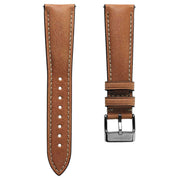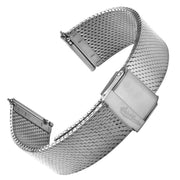There's something deeply romantic about wearing a piece of the cosmos on your wrist. Moonphase watches capture one of humanity's oldest fascinations – our relationship with the lunar cycle – and transform it into wearable art. Whether you're a seasoned collector or someone discovering complications for the first time, moonphase watches offer a perfect blend of practical heritage and poetic beauty.
Origins: From Ancient Computers to Wrist Wear
The story of moonphase timekeeping begins long before wristwatches existed. The earliest known device to display moon phases was the remarkable Antikythera mechanism from ancient Greece (circa 150 BC) – essentially the world's first analog computer. This bronze marvel predicted astronomical events, including lunar phases and eclipses, with stunning accuracy that wouldn't be matched for nearly two millennia.
During the Renaissance, grand astronomical clocks in European churches and cathedrals brought lunar displays to public spaces. These magnificent timepieces served both practical and spiritual purposes, helping communities track religious holidays tied to lunar calendars while showcasing the divine order of the heavens.
The transition to personal timekeeping came in the 17th and 18th centuries, when English and German clockmakers incorporated moonphase displays into grandfather clocks. The complication then migrated to pocket watches, becoming a symbol of sophistication and practical utility in an era when moonlight determined travel safety and farmers timed their planting by lunar cycles.
The leap to wristwatches happened in 1925, when Patek Philippe created the first moonphase wristwatch – a perpetual calendar piece that set the standard for decades to come.

How Moonphase Watches Work: Mechanical Poetry in Motion
At its heart, a moonphase watch is elegantly simple. The classic mechanism uses a 59-tooth gear that advances one notch every 24 hours, driven by the watch's movement. A disc decorated with two mirror-image moons rotates beneath an aperture (typically at 6 o'clock), gradually revealing and hiding the lunar imagery to simulate the Moon's waxing and waning phases.
After approximately 29.5 days – one synodic lunar month – the disc completes half a rotation, bringing the second moon into view and restarting the cycle. The curved "bosom"-style aperture creates the illusion of the Moon's changing shape as it appears and disappears.
However, there's a catch. The actual lunar cycle is 29.53059 days, making the 59-tooth mechanism an approximation that accumulates about 44 minutes of error per month. This means a standard moonphase display will be off by one full day after roughly 2 years and 7 months.
For those seeking greater precision, high-end manufacturers have engineered solutions. By using 135-tooth gears instead of 59, watches like the Rolex Cellini Moonphase achieve remarkable accuracy – requiring adjustment only once every 122 years. Some exotic pieces push precision even further, staying accurate for centuries or millennia, though these are more horological marvels than practical necessities.
The magic lies in how this mechanical system translates celestial motion into wrist-worn poetry. As the gear train slowly rotates the disc, watchmakers have crafted increasingly artistic representations of the lunar surface. Some feature hand-painted moons with visible craters, while others incorporate materials like meteorite fragments or luminous paint that glows softly in darkness. The finest examples create an almost three-dimensional effect, with textured surfaces that catch light differently as the "moon" waxes and wanes.

Why Own a Moonphase Watch in the Modern Era?
In our smartphone age, you might wonder why anyone needs a mechanical lunar calendar. The answer isn't practical – it's emotional and aesthetic. As one watch enthusiast perfectly put it, a moonphase watch "is more than just a device to keep track of time; it is a reflection of human fascination with the cosmos."
Historically, moonphase watches served genuine purposes. Before electric lighting, knowing the moon's phase meant knowing how much natural illumination to expect at night – crucial for travel, farming, fishing, and religious observances. Sailors used lunar information for tidal calculations, while religious communities tracked feast days tied to lunar calendars. Today, these complications persist because they add romance and visual interest to watch dials while connecting us to ancient ways of experiencing time.
There's an undeniable charm in having a miniature model of the lunar cycle on your wrist. Modern moonphase watches often feature beautifully rendered lunar discs – some so detailed you can see craters or even astronaut footprints (as famously depicted in certain Omega Speedmaster Moonphase models). It's functional art that sparks conversations and adds a touch of celestial wonder to everyday timekeeping.
Beyond aesthetics, owning a moonphase watch connects you to a rich horological tradition. It represents the marriage of astronomy and mechanical engineering that has fascinated humans for centuries. Each glance at the slowly changing lunar display serves as a reminder of our place in the cosmos and the rhythms that governed human life long before artificial lighting and digital calendars.
How to Set a Moonphase Watch
Setting a moonphase complication requires patience and the right reference point, but it's not as complicated as it might seem. Check out our detailed guide to find out more.
Top 5 Moonphase Watches
1. Christopher Ward C1 Moonphase

Christopher Ward's C1 features a mesmerizing aventurine dial with photorealistic moon surface details that glow in the dark. This British brand delivers Swiss automatic quality at honest pricing through direct-to-consumer sales.
2. Baume & Mercier Clifton Automatic Moon‑Phase

The Clifton showcases Richemont Group elegance with an in-house Baumatic movement offering five-day power reserve. The perfect balance of complications and readability in a versatile dress watch format.
3. IWC Portuguese Perpetual Calendar Moonphase

IWC's flagship complication combines a perpetual calendar with 577.5-year moonphase accuracy in their iconic Portuguese case, representing robust engineering with everyday wearability.
4. Omega Speedmaster Moonphase

Space heritage meets lunar poetry with Co-Axial Master Chronometer movement and detailed lunar disc featuring astronaut footprint tribute. The only sports chronograph that truly honours both timing and celestial tracking.
5. A. Lange & Söhne Lange 1 Moon Phase

German haute horlogerie pinnacle featuring asymmetrical dial layout and hand-finished movement with 122.6-year moonphase accuracy.
The Enduring Appeal of Lunar Time
Moonphase watches continue to fascinate watchmakers and collectors alike, with creative and innovative expressions of both romantic and scientific lunar aspects. From budget-friendly quartz models to haute horlogerie masterpieces, these complications remind us that the best watches tell more than time – they tell stories.
Whether you choose an entry-level piece or invest in a grand complication, a moonphase watch connects you to humanity's oldest relationship with celestial timekeeping. In our fast-paced digital world, there's something deeply satisfying about glancing at your wrist and seeing that ancient lunar dance playing out in miniature mechanical precision.
The moonphase stands as a poetic reminder that even in the age of smartphones and atomic clocks, we remain fascinated by the same celestial rhythms that guided our ancestors. It's a complication that celebrates both the romance of the night sky and the marvel of mechanical ingenuity – proving that the most enduring complications aren't always the most practical ones, but rather those that speak to our deepest sense of wonder about the cosmos above.













